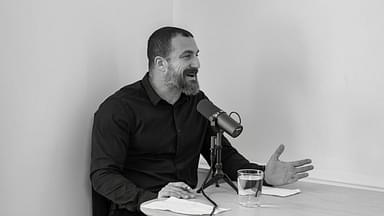For a long time, Stanford professor Dr. Andrew Huberman has focused his subject of study on mental and physical well-being and solutions catered to them. Practices like red light therapy, which he often swears by, play a huge role in gradually changing one’s way of living by positively impacting them. These practices cover various realms of health and fitness and, therefore, are accessible to a large number of people.
In his recent post on X, the neuroscientist pondered upon various pillars of physical and mental health. These pillars categorically determine where an individual’s mental and physical well-being lies. And while it was open to additions and subtractions, these pillars covered a lot of what Dr. Huberman would often discuss.
He began by clarifying that this was a theory he came up with. The neuroscientist’s idea was that if one were to regularly invest in these, they would yield positive long-term results. There are eight pillars in total.
1) Sleep
2) (Sun)light
3) Exercise
4) Stress Management
5) Relationships (Incl. To Self)
6) Nutrients (Amt., Timing, Content)
7) Oral Health & Gut Microbiome
8) Spiritual Grounding
Regulating one’s sleep cycle so that it yields 6–8 hours of good-quality sleep ensures that the body gets into a uniform rhythm. Similarly, getting around 10 minutes of sunlight first thing in the morning provides the necessary red light exposure that Dr. Huberman often talks about. Lastly, performing exercises that fall under zone 2 cardio workouts helped in maintaining physical health.
I am convinced that the 8 pillars of Mental & Physical Health are:
1) Sleep
2) (Sun)light
3) Exercise
4) Stress Management
5) Relationships (Incl. To Self)
6) Nutrients (Amt., Timing, Content)
7) Oral Health & Gut Microbiome
8) Spiritual Grounding
Additions? Subtractions?— Andrew D. Huberman, Ph.D. (@hubermanlab) February 1, 2024
Meanwhile, for mental well-being, parameters such as stress management, up-keeping relationships, and even focusing on spiritual grounding could be beneficial. To tie it up, dietary needs may be addressed, not only by keeping a check on the amount and kind of nutrients consumed but also by considering taking supplements to replenish gaps in nutrition.
Striking a balance between physical and mental well-being is tricky but possible since the pillars are interlinked. With the guidelines provided by Dr. Huberman, it’s evident how small changes can make a huge difference. Something as simple as training the body to adapt to a day-and-night schedule helps set appropriate reactions in the brain and body. Therefore, these pillars are crucial for health.
Dr. Andrew Huberman explains dark and light exposure
As previously mentioned, the body needs to act according to the time of the day to set a rhythm. This occurrence leads to the neuroscientist’s theory about dark and light exposure. Evidently, it is the individual coming in contact with light or darkness, depending on the time of the day.
For individuals, daylight provides increased levels of cortisol necessary to get a jumpstart for the day. While the neurochemical increases stress, in this case, it helps with the body’s energy levels. Consequently, as dusk sets in, one must lower these levels to enter a sleepy state. This phenomenon calls for dark exposure that involves dimming the lights and utilizing red lights to prompt an appropriate response.





